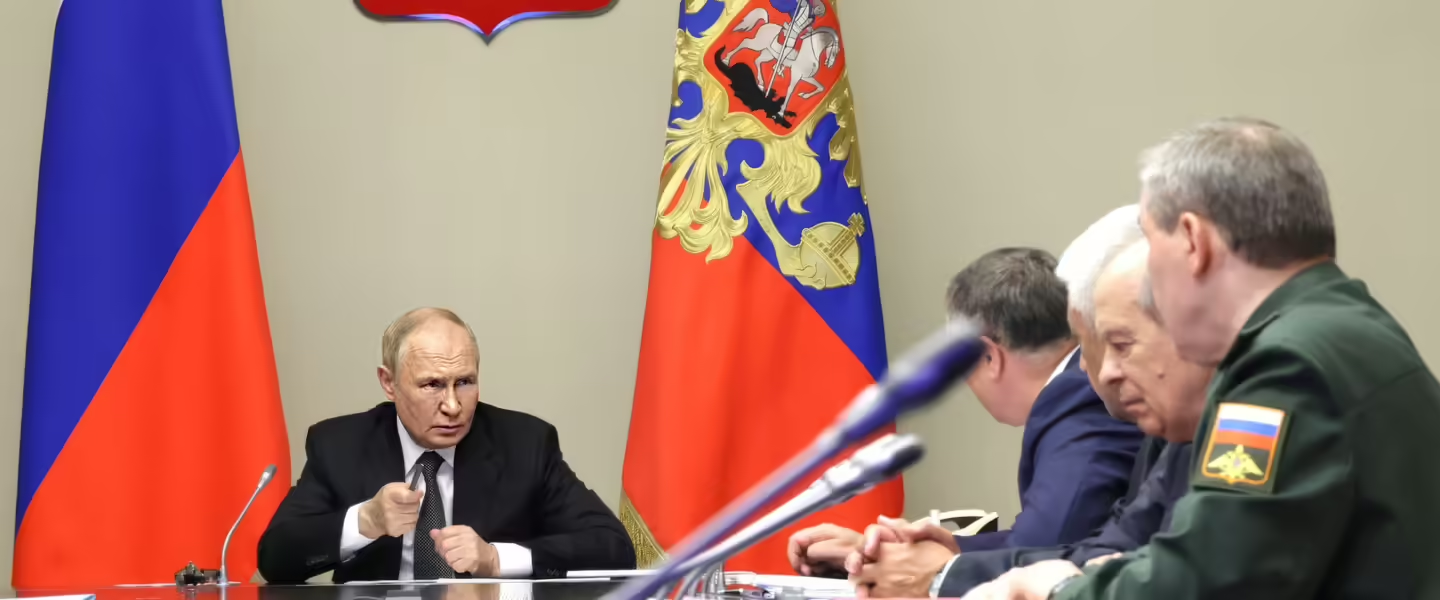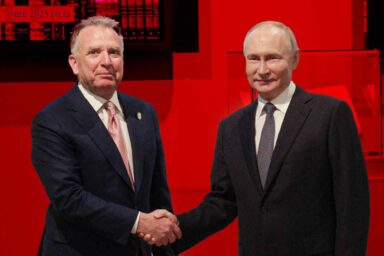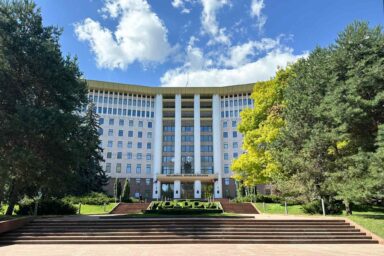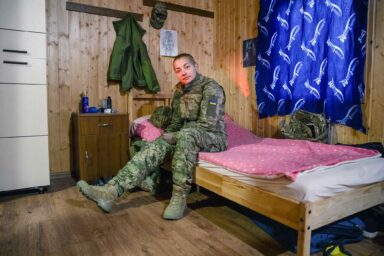Morale booster? Bargaining chip? Symbolic — or pragmatic?
|
Listen To This Story
|
Ukraine’s August 6 incursion into Russian territory around Kursk is turning out to be far more substantial than originally thought. There are conflicting reports concerning the exact number of Ukrainian soldiers involved.
A Ukrainian website, Online, is reporting that up to four of Ukraine’s best brigades, totaling more than 5,000 troops, may be involved. Since Ukrainians often split their brigades into smaller, battalion-sized units, it’s hard to tell exactly how many Ukrainians are actually committed.
Russian sources had originally estimated the size of the Ukrainian force at 300 men. It is now clear that the Ukrainian force is a great deal larger, as the fighting has extended over three oblasts (the Russian equivalent of a province) and an estimated 400 square miles of Russian territory is currently occupied by the Ukrainian Army.
According to Online, the invading force consists of elements of Ukraine’s 80th Brigade, equipped with a mix of Russian and American armored vehicles operating in the region near Kursk. The 22nd and 88th mechanized brigades and the 80th amphibious assault brigade are also involved. They are all considered crack units.
Ukraine has launched lightning attacks across the border into Russia in the past, but these involved ethnic Russian soldiers fighting for Ukraine. This time, Ukrainian main force units are carrying out the attack, and they are staying longer than anyone expected.
It marks the first time since World War II that a foreign army has launched an attack on Russian soil.
Thus far, Ukraine is keeping silent about its ultimate objective and how long it plans to stay. There was early speculation that Ukraine might be trying to create a buffer zone to protect Kharkiv from future Russian attacks, or that the goal might be to draw Russian forces away from the eastern region of Donbas, where Russian units that have more men and more ammunition than the Ukrainians have been making slow but steady progress. Another possible explanation is that the Ukrainian army may simply have needed a boost in morale after recent Russian advances.
Andriy — a Ukrainian who has several friends at the front and who, like most Ukrainians protecting themselves and their families from Russian retaliation, asked that we only use his first name — suggests a simpler explanation. “The Russians have heavily fortified their positions in the east,” he said, “so it makes sense to strike in the northeast where they have no real defenses.”
The day after the assault began, Russian President Vladimir Putin admitted publicly that the Ukrainians had launched “a large-scale provocation.” Valery Gerasimov, chief of the general staff of the Russian army, announced that the Ukrainians had been stopped. But reports from the field said that the battle was still going on and that the combat was intense.
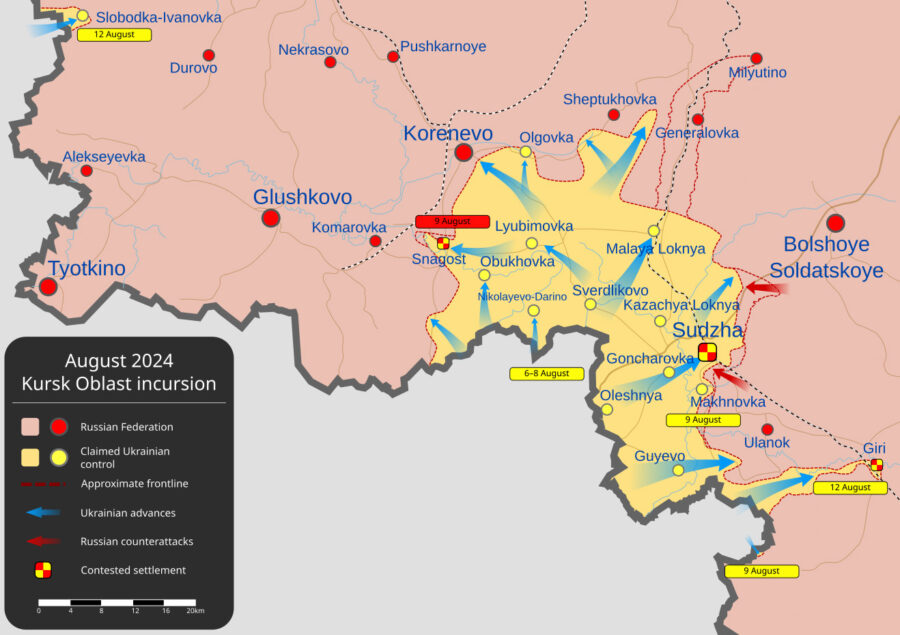
Photo credit: Ecrusized / Wikimedia CC0 1.0 DEED)
On August 9, Russian authorities declared they were sending reinforcements into the Belgorod, Bryansk, and Kursk oblasts. At least one of the Russian troop convoys was destroyed. Moscow admitted that it had been forced to evacuate at least 76,000 Russian civilians from the area around Kursk. The next day, Ukraine’s president, Volodymyr Zelenskyy, said that Ukraine had begun to “push the war into the aggressor’s territory.”
A possible target, according to the US-based Institute for the Study of War, might be Sudzha, an important transit hub for the pipeline that carries Russian natural gas to Europe. Another target might be a Russian nuclear power plant at Kurchatov. Both of these objectives make sense. In the meantime, the Ukrainians are not saying how far they intend to go or how long they intend to stay.
War Mapper, a “one-person project” that uses open-source intelligence to map conflict zones, reported that the Ukrainians were dramatically increasing their hold on Russian territory around Kursk and currently hold more than 120 square miles of Russian territory. Putin subsequently suggested that Ukraine might be trying to capture the territory as a bargaining chip for eventually negotiating a ceasefire.
A Ukrainian battalion commander in the Sumy region was vague about Ukraine’s ultimate objective but appeared to agree with Putin’s assessment. “Our strategy is to force the Russians to ease pressure on certain points of the front, particularly Toretsk [in the Donetsk Oblast],” he said. “Perhaps it is also to capture Russian territory to negotiate in exchange for territory captured by Russia.”
Andriy, who has been following events closely, thinks that the Ukrainian assault could be aimed at forcing Putin into a new Russia-wide recruitment drive. “It’s all about mobilization,” Andriy said. “If Putin orders a new mobilization, it will take people away from their jobs and that will take down Russia’s economy. People won’t stand for it.”
Andriy insisted that Russia’s invasion of Ukraine was motivated by Russia’s crushing internal poverty, explaining:
Ukraine was one of the former Soviet Republics. Russians can’t stand the fact that now we are independent and moving closer to the West, [and] we are wealthier than they are. Putin wants to recreate the old Soviet Union, but he can’t do it. He talks about saving the Slavic people, but the people who made up the former Soviet Union came from everywhere. They weren’t only Slavs, and if you ask them to go to war because you want to save Slavs, they won’t do it. It means nothing to them.
Mykhailo Podolyak, an adviser to Zelenskyy, favors the idea that Ukraine is looking for leverage to use if and when Putin decides to end a war of attrition that does not appear to be going anywhere. Podolyak noted that holding a chunk of Russian territory could “improve Kyiv’s position in future peace talks with Moscow.”
A former Ukrainian Army colonel, Viktor Kevlyuk, who now works as an analyst at Kyiv’s Center for Defense Strategy, told WhoWhatWhy, “The military-political goal is to show the world the weakness and internal lack of preparedness of the Russian Federation when the war is transferred to its sovereign territory.”
International risk consultant Stéphane Audran agrees. “Seizing territory, bringing destruction to the aggressor, making its population flee before an invasion — this represents a significant political cost for the Kremlin,” he said. Audran added that it was crucial for Ukraine to restore a narrative of victory, while shifting the sentiment of defeat to the opposing camp.
Emil Kastehelmi, an analyst for the Black Bird Group, another open-source intelligence group, cautioned that the real question is how long Ukraine can keep the offensive going. “It all depends on how much power Ukraine wants to commit to the Kursk offensive,” he said. “Ukraine can’t commit too many brigades. They need to keep reserves to respond to Russian threats on the frontline.”
Ronin, a soldier who goes only by his call sign and is knowledgeable about the units deployed, thinks they may try to hold on longer than expected. “I can’t reveal everything,” he said, “but they’ve taken vehicles and materials that are designed to hold positions. It is the kind of stuff that you need to maintain a new front for the long term.”
Ronin thinks that everything depends on how quickly the Russians can respond. “It all depends on how quickly they can resupply their forces,” he said. And that, in turn, depends on Ukrainian artillery capacity to hit the arriving Russian reinforcement columns. “If they [the Ukrainians] succeed,” Ronin said, “they will create breaches in the front lines around Kursk and relieve the pressure on the eastern and southern fronts.”
Konrad Muzyka, an analyst at the Polish think tank Rochan Consulting, noted that the operation can be considered a success only if it reduces Russian attacks in the Donetsk region. That will only happen if Kyiv creates a strategic dilemma for Moscow that strengthens its position in future negotiations with Moscow. If Ukraine is driven back without achieving tangible results, and if it suffers heavy losses while Russia continues its advances in the Donbas, Muzyka thinks the operation will have failed.
Touman, a battalion commander, who goes by his call sign, suggested the stakes may be worth the risk. “The Kremlin is weakened,” he said. “Their army is tied up along the entire front line. Sometimes all it takes is one event to regain the advantage.”
